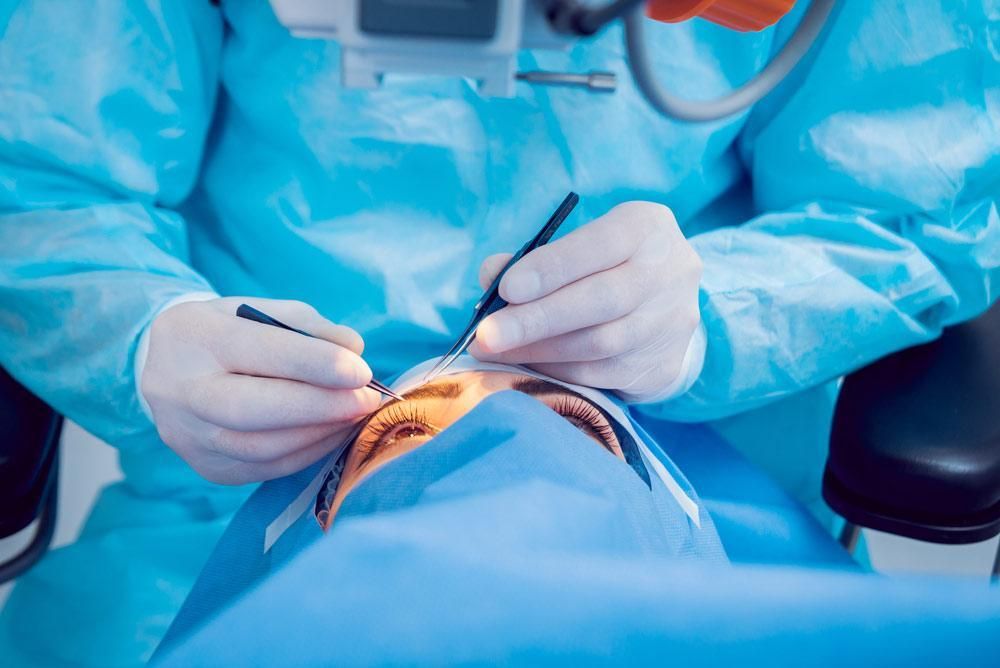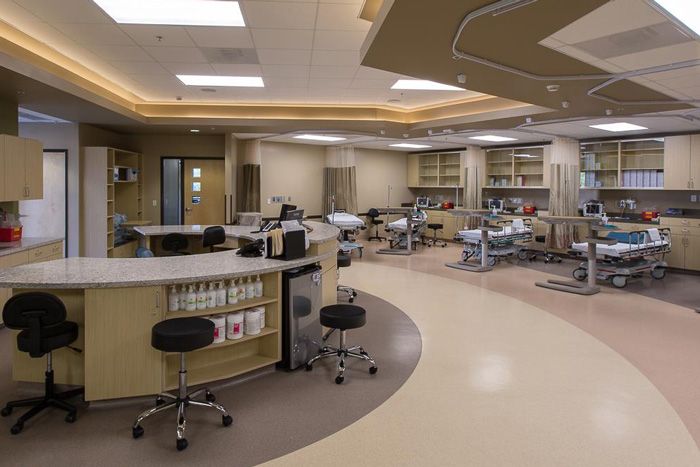

“EXCELLENT SURGEONS THAT ARE CARING PEOPLE, TOO!”
The Best for RLE Eye Surgery in Tucson and Nearby Areas
Refractive lens exchange (RLE) corrects your vision by removing your natural clear lens and replacing it with an intraocular lens implant (IOL). The procedure is able to correct nearsightedness, farsightedness, and astigmatism. It is often performed in those over 40 who want to decrease their dependence on contacts or glasses.
To ensure that you have the greatest chance of success, trust a qualified ophthalmologist who has performed this type of eye surgery before.
-
Fellowship Trained and Board Certified Refractive Surgeons
-
Customized LASIK & PRK Surgery
-
Implantable Collamer Lens
-
Refractive Lens Exchanges with Premium Lens Implants
-
Two Convenient Offices & a State-of-the-Art Surgery Center
If you’re in the Tucson and Oro Valley area, you will find an experienced eye surgeon at Fishkind, Bakewell, Maltzman & Hunter Eye Care and Surgery Center.
See What Makes Our Tucson Eye Care Specialists Different
Hear What Our Customers Say
The Process
RLE Eye Surgery in 4 Easy Steps
In our practice, RLE is usually performed on an outpatient basis.
Your surgeon will conduct pre-operative measurements and discuss your lens options and desired vision outcomes at your initial evaluation.
The day of surgery, before you leave home, you will use eye drops to dilate your eye and start preparing it for the procedure. After your arrival at the surgery center, your eye surgeon will use local anesthesia drops to numb your eyes for surgery.
After your eye is dilated and prepared for surgery, the surgeon will begin your procedure while you are given conscious sedation instead of general anesthesia.
Once adequate anesthesia has been achieved, the area around the operative eye will be cleansed for sterility and a surgical drape will be placed. A small device known as a speculum will then be placed to keep your eye open during the procedure. There will be no discomfort.
A small incision is then made in the cornea, or clear window at the front of the eye, and a viscous gel is injected into the eye in order to maintain space and protect the other ocular structures during surgery. The “main” corneal incision is then carefully made using an extremely sharp and precise blade made of diamond. Next, a circular opening is created in the front of the thin membrane, or capsule, which surrounds the lens, and fluid is injected inside to separate the entire lens from its attachment to the capsule.
An artificial, permanent lens implant, made of a type of plastic, is then inserted into the capsular “bag,” taking the place of your natural lens. This implant, which helps focus the incoming light on your retina, is held in place by two haptics, or curved arms. Once the implant is in place, the incisions are closed, usually without stitches, and the surgery is complete.
Your eyes should start healing and your vision will improve within two to five days following your cataract surgery. At first, your vision is likely to be blurry but that blurriness will gradually become sharpened. You will be given an eye drop schedule and following it is vital to the success of the surgery and to reduce the possibility of infection post-operatively. You will be seen by your surgeon the day after your procedure and then have a follow-up visit within 10-14 days to check on the health of the eye and if necessary, to prepare for the second eye surgery. Very rarely problems may occur following surgery. One such problem or risk is the development of residual astigmatism following the surgery, which can be corrected and your surgeon will discuss the options with you.
You will return to our office the following day for a postoperative examination. The flap will be checked to assure that it is healing properly. If present, the contact lens will be removed at this time. Vision at this time is usually between 20/20 and 20/40, depending on the degree of refractive error corrected. Vision may continue to improve over the next few weeks before stabilizing fully. At this point, you should be able to go about your business as usual… with one exception- no more glasses or contact lenses!

What Are the Benefits of RLE?
Refractive lensectomy may be a good option for patients who are moderately to highly hyperopic (farsighted) or for those in whom other refractive procedures might not provide stable vision, such as patients over 55 years old. Additionally, it may be appropriate for those seeking good uncorrected vision at both distance and near via the use of multifocal intraocular lenses.
Additionally, many intraocular lens implants (IOL) exist, allowing postoperative vision to be tailored to the individual patient’s needs.
How to Choose A Good RLE Eye Surgeon
As with all surgical procedures, you should thoroughly research your options to find the best surgeon for you. First, check to see if your routine vision insurance plan provides a discount with your surgeon or the facility. Second, verify that your surgeon is local to your area and will be available for your post-operative care.
Find a facility that has high-quality equipment and experienced surgeons and staff. Also, carefully research the experience of the eye surgeons you have under consideration. Find one who has a good rate of success over a long history of performing eye surgeries.

See Now – Pay Later! Finance Your RLE Procedure with CareCredit!

Why Our Facility Is a Great Eye Care Center for Your Eye Surgery
We know that you have a choice of several surgeons and locations for your RLE surgery and our team of experts look forward to providing the highest quality care to ensure the success of your RLE procedure. Our experienced surgeons, high-tech equipment, and personalized care provide you with the best outcomes for your vision. Your RLE procedure also includes a year of follow up exams to ensure you maintain your best possible vision.
FAQ
RLE Eye Surgery Questions & Answers
RLE surgery is very common and is generally a safe procedure and nearly identical to cataract surgery. Although there’s always some risk when it comes to surgical procedures, overall, RLE is considered a safe and effective means of restoring vision.
If you’re interested in RLE, talk to your eye doctor about the qualifications. If you come to us, our ophthalmologists will review your medical history and conduct a comprehensive eye exam to evaluate your eye health and visual acuity to see if you would be a good candidate for this procedure.
In general, to be eligible for RLE surgery, you will be aged 45 years or older, have good eye health, have a stable eye prescription for one year prior to surgery, and have no medical conditions requiring medications that can interfere with your healing.
No. Your eye surgeon will put anesthetic drops in your eyes prior to your procedure to ensure you feel no pain. If you feel discomfort after the procedure, we can prescribe drops to minimize your discomfort and expedite your healing. Most patients feel fine within a few days.
We cannot guarantee every patient will attain 20/20 vision after RLE surgery. The implant can be chosen to focus your eye at any distance you desire. While most choose to focus at distance, some prefer to see most clearly at near, particularly if they have always been myopic, or nearsighted.
At Fishkind, Bakewell, Maltzman & Hunter we perform these measurements with the Zeiss IOL-Master, the most advanced, accurate device for this purpose, which uses a laser to scan the eye in just seconds.
While these calculations are extremely accurate in most cases, the expected results are not always achieved. Most patients obtain vision good enough to drive without glasses.
Rarely, the post-operative refraction (eyeglass prescription) will be significantly different than expected. In these unusual cases, additional surgery, including removal and replacement of the lens implant, may be required to achieve the desired result. The appearance of an implant in the eye at the end of surgery is shown right.
The majority of lens implants inserted during cataract surgery are considered ‘monofocal,’ meaning that they focus light at only one location, usually in the distance. This means that reading glasses will be required for close-up tasks such as reading- without them near vision will be blurred. Another option is the ‘multifocal’ lens implant. Such implants allow for clear vision at distance, as well as good vision at mid-range and near. Each type of lens has specific advantages and disadvantages. You can discuss these options with one of our physicians during your evaluation.
The lens implanted during RLE is designed to be a lifetime solution to your existing vision problems. Because the lenses are created of specialty medical-grade acrylic they cannot grow or change like the eye’s natural lens.



